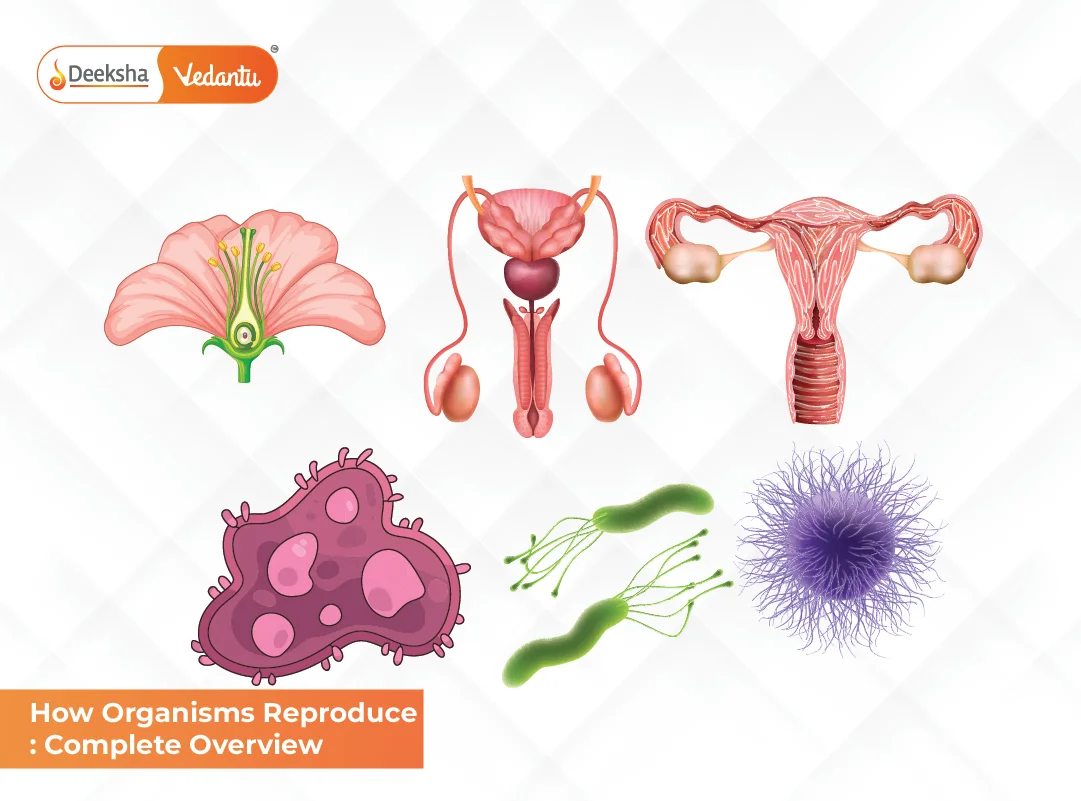Reproduction is one of the defining characteristics of living organisms. It ensures the continuation of a species from generation to generation. Whether it’s a single-celled bacterium dividing or a complex human giving birth, all forms of reproduction serve the primary function of perpetuating life on Earth. This biological process not only maintains population balance but also facilitates genetic diversity-an essential driver of evolution.
In Class 10 Biology, understanding how organisms reproduce lays a strong foundation for more advanced studies in genetics, human biology, and evolution. This chapter covers both asexual and sexual reproduction mechanisms, explaining each with clarity and real-life relevance.
What is Reproduction?
Reproduction is the biological mechanism through which organisms produce new individuals of the same species. It plays a vital role in maintaining biodiversity, stability of ecosystems, and transmission of genetic material from one generation to the next.
Explore: How Do Organisms Reproduce?
Reproduction doesn’t always result in variation. Some organisms create exact copies, while others produce offspring with different traits. The mode of reproduction-whether sexual or asexual-determines the extent of genetic similarity between parents and offspring.
Types of Reproduction
Organisms use different reproduction methods based on their complexity and environment. The two broad categories are:
- Asexual Reproduction: Offspring arise from a single parent without the involvement of gametes.
- Sexual Reproduction: Involves the fusion of male and female gametes from two parents, resulting in genetically varied offspring.
These processes have significant biological consequences, including how quickly species evolve and adapt to their surroundings.
See more on reproduction types used by single organisms
Asexual Reproduction
In asexual reproduction, one organism gives rise to a new organism without the formation of gametes. The offspring are clones-genetically identical to the parent. This method is common among unicellular organisms and some simple multicellular organisms.
Characteristics of Asexual Reproduction:
- Requires only one parent
- Occurs through mitotic cell division
- Rapid and energy-efficient
- No genetic variation (except in rare cases of mutation)
Common Methods of Asexual Reproduction:
- Binary Fission: The parent cell divides into two identical daughter cells. Seen in Amoeba and Bacteria.
- Budding: A new organism grows from the body of the parent (e.g., Hydra, Yeast).
- Fragmentation: An organism breaks into pieces, and each piece grows into a new organism (e.g., Spirogyra).
- Spore Formation: Spores are lightweight reproductive units that spread and grow into new individuals (e.g., Rhizopus).
- Vegetative Propagation: Found in plants where parts like stems, roots, or leaves give rise to new plants (e.g., Potato, Rose, Bryophyllum).
This method is advantageous when the environment is stable and favorable for rapid multiplication.
Sexual Reproduction
Sexual reproduction is more complex and involves the fusion of two different types of gametes-one from each parent. It is widespread in both plants and animals, including humans.
Characteristics of Sexual Reproduction:
- Involves two parents (male and female)
- Requires specialized sex cells (gametes)
- Offspring show genetic diversity
- Occurs through meiosis and fertilization
- Slower but promotes adaptability
Stages in Sexual Reproduction:
- Gamete Formation: Male and female gametes are formed via meiosis.
- Gamete Transfer: Male gametes are transferred to the site of the female gamete.
- Fertilization: The gametes fuse to form a zygote.
- Zygote Development: The zygote undergoes cell division and differentiation.
- Embryonic Development: The embryo matures into a new individual.
Explore the details of sexual reproduction
Sexual Reproduction in Plants and Animals
In Flowering Plants:
- Pollination: Pollen grains from the anther are transferred to the stigma. It can be self or cross-pollination.
- Fertilization: Male gamete in the pollen fuses with the egg cell in the ovary.
- Seed and Fruit Formation: The zygote becomes an embryo, and ovary transforms into fruit.
In Animals:
- Can involve internal fertilization (humans, dogs, birds) or external fertilization (frogs, fishes)
- The zygote grows into an embryo, which eventually develops into a fully formed organism
Human Reproduction Overview
Humans reproduce sexually through internal fertilization and complex reproductive systems that ensure the development of the zygote into a baby.
Male Reproductive System:
- Main Organs: Testes, epididymis, vas deferens, seminal vesicles, urethra, penis
- Function: Produces sperm and transfers them to the female system
Female Reproductive System:
- Main Organs: Ovaries, fallopian tubes, uterus, cervix, vagina
- Function: Produces ova (eggs), facilitates fertilization, and supports fetal development
The coordination of hormonal and structural changes ensures reproduction and continuation of human life.
Importance of Variation in Sexual Reproduction
Variation results from genetic recombination during meiosis and fertilization. It serves several biological purposes:
- Increases the adaptability of populations
- Provides a survival advantage in changing environments
- Prevents extinction due to uniform susceptibility to disease
- Forms the basis of evolution through natural selection
Explore: Do Organisms Create Exact Copies of Themselves?
Comparison Table: Asexual vs Sexual Reproduction
| Feature | Asexual Reproduction | Sexual Reproduction |
| Number of Parents | One | Two |
| Gametes Involved | No | Yes |
| Genetic Variation | Absent | Present |
| Speed of Reproduction | Fast | Slower |
| Energy Requirement | Low | High |
| Examples | Amoeba, Hydra, Yeast | Humans, Birds, Plants |
Link Between Reproduction and Heredity
Reproduction is intricately connected with heredity, the passing of traits from one generation to the next. In sexual reproduction, chromosomes from both parents carry genes that determine the traits of offspring. This genetic mixing leads to individual uniqueness and drives biological evolution.
FAQs
Q1.What is the main purpose of reproduction in organisms?
Reproduction ensures survival, continuity, and the maintenance of the species through the generation of new individuals.
Q2.What is the difference between asexual and sexual reproduction?
Asexual reproduction involves one parent and no genetic variation, while sexual reproduction involves two parents and creates genetically diverse offspring.
Q3.Why is variation important in sexual reproduction?
Variation enhances adaptability, allows evolution through natural selection, and increases a population’s chances of surviving environmental changes.
Q4.Can plants reproduce both sexually and asexually?
Yes. Many flowering plants can reproduce sexually via pollination and fertilization, and asexually through vegetative propagation like runners, tubers, and cuttings.
Q5.Is cloning similar to asexual reproduction?
Yes, cloning produces genetically identical individuals, much like natural asexual reproduction, but is achieved through artificial or laboratory processes.
Q6.What organisms show both types of reproduction?
Some organisms like algae, fungi, and mosses can reproduce both sexually (during adverse conditions) and asexually (in favorable conditions).
Conclusion
Reproduction is central to the continuation of life on Earth. While asexual reproduction ensures quick and consistent multiplication, sexual reproduction allows for diversity and adaptation. Understanding these biological processes enables students to comprehend how organisms grow, evolve, and survive in a complex world.
For Class 10 students, grasping these concepts is crucial for academic success and deeper insight into life sciences. From binary fission in Amoeba to gamete fusion in humans, the diversity of reproductive strategies across life forms is both fascinating and essential.
Table of Contents










Get Social